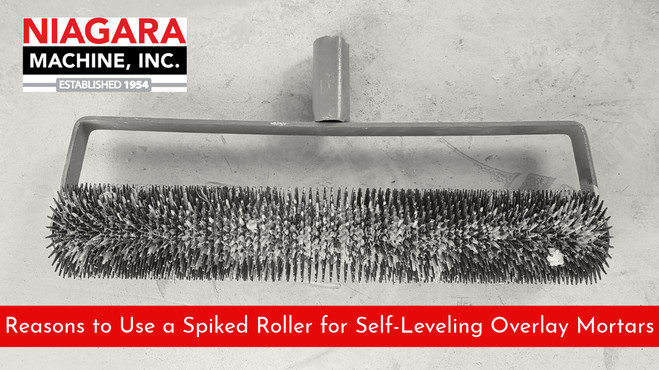Reasons to Use a Spiked Roller for Self-Leveling Overlay Mortars
26th Feb 2024
Concrete is produced using sand, cement, and large coarse aggregate. Cement self-leveling overlay mortars are produced with sand, cement, and small aggregate. When designing a mix that is flowable when placed in a thin cross-section, the aggregate needs to be no larger the half of the final thickness of the pour. If you are placing a ½” overlay, the aggregate needs to be less than ¼” in size. If the aggregate is larger, it will tend to stack on top of other aggregates and not level out. With aggregate at less than ¼” it is considered a mortar and not concrete.
When placing a “self-leveling” mortar you will notice it really doesn’t level on its own. It needs some help. Back in the day, smoothing paddles were primarily used. It has a spring steel blade with a standup handle, similar in appearance to a squeegee. Dragging the smoothing paddle across the wet mortar breaks the surface tension at the surface producing flow.
As material technology developed, alternative placement methods were also tested and accepted. The spiked roller was one of them. A spike roller has many long spikes around a cylindrical (tube-shaped) core. The material manufacturers typically recommended the roller brand and the length and diameter of the spikes.
Break Surface Tension
To get the overlay mortar to flow, it needs to be vibrated or agitated. Once the surface tension is reduced, the material will flow freely. The spiked roller penetrates the material as it is rolled across the wet material. This action vibrates the overlay material allowing it to settle producing a flatter surface.
Air Release for a Flawless Finish
When the overlay mortar is mixed, air is entrapped in the wet material. This is a natural process that cannot be eliminated. If the material cures with the entrapped air inside, the performance of the cured material would be compromised.
The spiked roller produces passageways in wet material for the entrapped air to escape. If rolled early before its initial set time, these passageways will heal on their own leaving a smooth surface.
Ensuring Even Distribution
Although the spiked roller is not a tool designed to move material around on the slab, by creating more flow, the material moves to even out the thickness.
Enhanced Adhesion and Performance
Overlay self-leveling mortars develop their bond strength by mechanically attaching to the substrate. Depending on the surface aggressiveness produced during the surface profile step, there might be irregular voids in the substrate. Ideally, you want the material to flow into these small areas filling all the void structure. The vibration of the spiked roller enables the material to do just that while increasing the bond strength.
Professional Results
Overlay mortars are typically installed to cover up an undesirable substrate, to have a fresh canvas to produce a designer floor, to level a floor, or to create uniformity throughout a space. With all these reasons, one thing they all have in common is the finished surface needs to be smooth with no ridges.
When used properly, the spiked roller will induce movement and level the surface. The technique used with the spiked roller to level the overlay surface is a very easy one to learn. With minimal practice, your floors will look like you have been doing it for years.
Efficiency in Application
When installing an overlay mortar, labor-reducing procedures will only reduce time on the job which correlates to higher profits. The spiked roller will produce a flatter floor with minimal training. It levels the self-leveling mortar faster, increasing efficiency.
Conclusion
When placing a self-leveling overlay mortar, several important factors need to be addressed. First, the substrate needs to be prepared per the overlay mortar manufacturer's recommendation. This might be to grind or shot blast. Niagara Machine carries all types of equipment and tooling to perform the method required.
This material will need to be mixed onsite. Niagara Machine represents several manufacturers that manufacture mixing equipment well suited for the task. Once mixed, the material needs to be placed and smoothed. Gauge rakes allow the placement of the material at a predetermined thickness. Then the spiked roller is used to flatten the material.
No matter if you are interested in finding out more about surface preparation or the placement of a self-leveling overlay mortar, contact Niagara Machine for all your needs.

